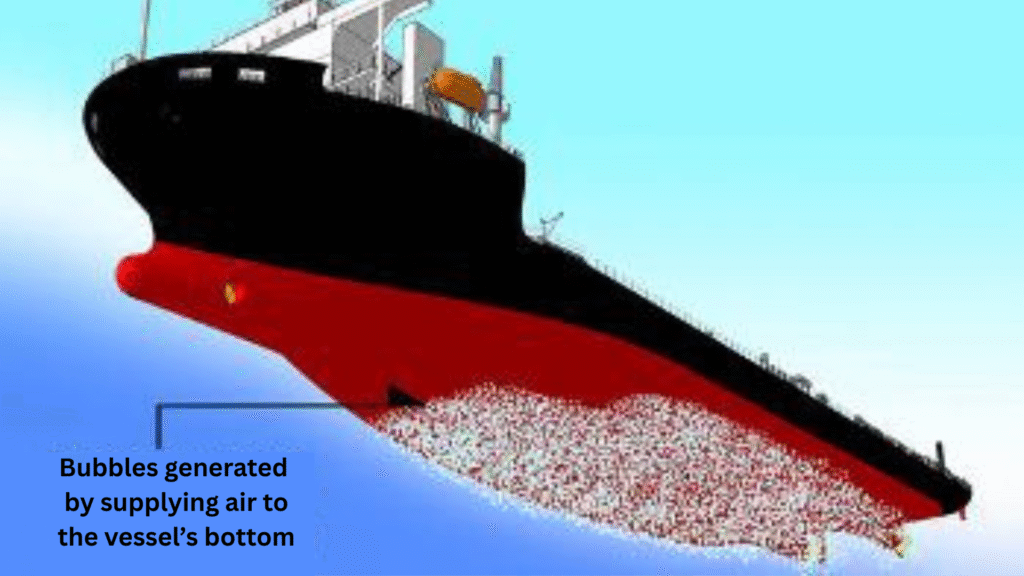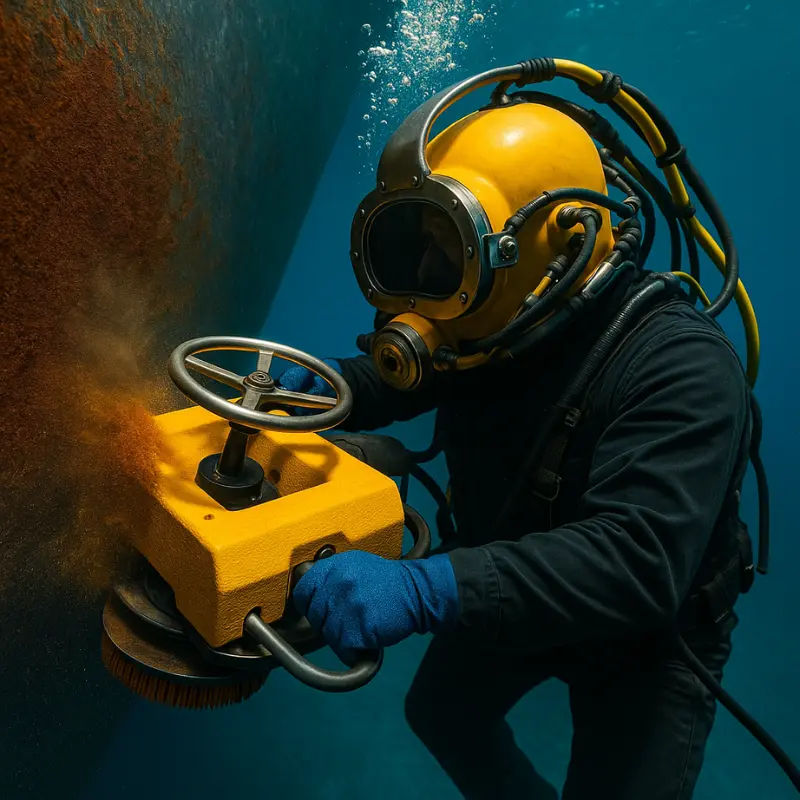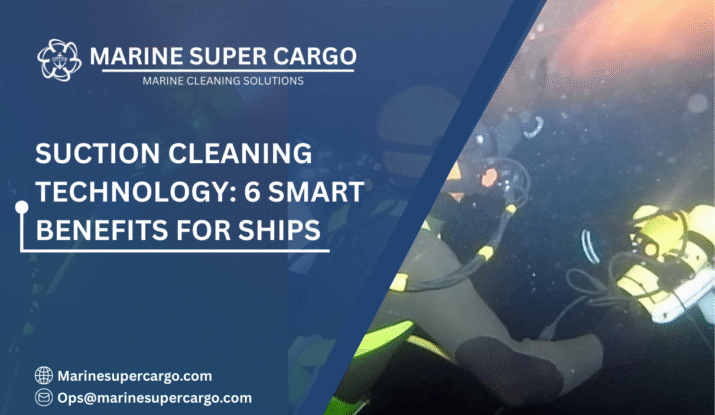Think of your vessel like a marathon runner wearing heavy boots. Every extra ounce of resistance makes it harder, slower, and costlier to move forward. In the shipping industry, that resistance is marine biofouling—barnacles, algae, and sludge clinging to ship hulls, dragging down performance and driving up fuel bills.
Traditionally, cleaning methods have revolved around brushes, scrapers, and water jets, but these can be damaging, messy, and environmentally risky. Enter Suction Cleaning Technology—a modern, eco-friendly solution harnessing vacuum systems to remove biofouling while safeguarding coatings and marine ecosystems.
In this article, we’ll unpack how Suction Cleaning Technology works, its benefits, where it’s applied, and why it’s becoming a go-to choice for sustainable hull maintenance.
Why Ship Hulls Need Regular Attention
Hull cleaning isn’t vanity—it’s a business-critical need. Biofouling builds up quickly, especially for ships operating in warm or coastal waters. The consequences are stark:
- More drag: A fouled hull increases friction, forcing engines to burn excess fuel.
- Higher costs: Fuel expenses rise—often by millions annually for large fleets.
- Environmental strain: More fuel equals more CO₂, NOₓ, and SOₓ emissions, conflicting with MARPOL Annex VI targets.
- Regulatory scrutiny: The International Maritime Organization (IMO) and IAPH insist ships have biofouling management plans to limit invasive species spread.
Clean hulls make ships faster, greener, and cheaper to operate. Dirty ones slow them down like anchors dragging beneath the waves.
Old Methods, New Challenges
For decades, hull cleaning meant sending divers underwater with brushes or using robotic scrapers. While effective, these methods have clear limitations:
- Diver risks: Safety hazards like low visibility, entanglement, and decompression.
- Coating damage: Hard brushes or high-pressure jets often strip costly anti-fouling paints.
- Uncontrolled debris: Fouling waste drifts into harbors, spreading invasive organisms.
- Operational downtime: Traditional cleaning requires pauses in operations.
With stricter regulations and rising fuel costs, the industry needed smarter tools. That need gave rise to Suction Cleaning Technology.

What is Suction Cleaning Technology?
At its core, Suction Cleaning Technology uses controlled vacuum systems to dislodge and capture biofouling directly from ship hulls. Instead of scattering debris into the ocean, it traps particles inside onboard filtration systems for proper disposal.
Imagine using a vacuum cleaner on your carpet—except underwater, on a steel hull, with fouling instead of dust. That’s the principle at work here.
Also read about underwater ship hull cleaning in Ecuador.
How Suction Cleaning Technology Works
Step into the science behind it:
- Attachment: Robotic or diver-operated suction heads attach firmly to the hull surface.
- Vacuum force: The suction head generates negative pressure against the surface, lifting fouling away.
- Gentle brushing: Some models combine soft brushes with suction to loosen slime.
- Waste capture: Biofouling is funneled through vacuum hoses into filtration tanks onboard support vessels.
- Eco-disposal: Captured waste is processed or disposed of ashore under compliance protocols.
Unlike brute-force cleaning, suction systems aim for precision, minimizing coating impact and environmental release.
Benefits of Suction Cleaning Technology
1. Fuel and Cost Savings
By reducing hull drag, Suction Cleaning Technology delivers measurable fuel savings, often cutting 10–15% in consumption. For fleet operators, this means millions in annual cost reductions.
2. Coating Preservation
Because suction is gentler than scrapers or water jets, valuable anti-fouling coatings remain intact, extending their lifespan and delaying costly repainting.
3. Environmental Protection
The greatest advantage is waste capture. Instead of biofouling dispersing into local waters, invasive organisms are collected and properly treated—aligning with IMO biofouling guidelines.
4. Safety Enhancement
Using robotic platforms reduces or eliminates the need for divers in risky underwater conditions, lowering liability and improving worker safety.
5. Regulatory Compliance
With captured debris and efficient cleaning, operators stay aligned with MARPOL, IAPH, and IMCA standards while demonstrating eco-stewardship.
6. Reduced Downtime
Suction systems can often operate while ships are alongside in ports, minimizing operational delays.
At Marine Super Cargo, we provide trusted marine cleaning solutions across 1,100+ ports worldwide. From hold cleaning to underwater hull cleaning and tank cleaning, our services are designed to keep your fleet fully compliant, efficient, and cargo-ready. pic.twitter.com/N5VYZZjlQH
— Marine Super Cargo (@Marinsupercargo) September 11, 2025
Applications Across the Marine Industry
Suction Cleaning Technology is gaining ground across sectors:
- Container ships: Maintain efficiency between global port stops.
- Bulk carriers & tankers: Major fuel savings on long routes.
- Offshore platforms: Clean legs, risers, and subsea structures.
- Naval vessels: Optimize performance while safeguarding stealth coatings.
Its adaptability across vessel types makes it an attractive choice for modern fleets.
Suction Cleaning vs. Other Technologies
When we compare Suction Cleaning Technology with alternatives such as brushes, cavitation jets, or water jet systems, differences become clear:
| Method | Pros | Cons |
|---|---|---|
| Brushes & Scrapers | Simple, effective on heavy fouling | Coating damage, debris spread |
| High-Pressure Jets | Strong removal power | Risk of stripping coatings |
| Cavitation Jet Cleaning | Gentle, effective for biofilm | More complex and power-hungry |
| Suction Cleaning Technology | Waste capture, eco-safe, coating friendly | Initial investment, operator training |
This positions suction systems as an eco-friendly balance of efficiency and compliance.
Environmental Context
The IMO and IAPH are increasingly strict about invasive species transfer. Without containment, fouling scraped from one port can spread across ecosystems within hours. Suction Cleaning Technology specifically addresses this concern with containment and disposal.
It’s shipping’s version of vacuum-sealed cleaning—no mess, no ecological damage.
Challenges of Suction Cleaning Technology
Despite all its promise, challenges remain:
- High upfront cost can deter smaller operators.
- Training requirements for crews to use robotic suction equipment.
- Effectiveness on heavy fouling may be lower than brute-force methods.
- Energy demands for vacuum pumps and filtration systems.
Still, ongoing innovation and adoption are reducing costs and improving scalability.

The Future of Suction Cleaning Technology
Technology is moving fast. Researchers and innovators are working to combine Suction Cleaning Technology with robotics and AI-driven navigation. In the near future, we may see:
- Fully autonomous suction robots deployed at smart ports.
- Predictive cleaning schedules powered by AI, detecting fouling hotspots.
- Hybrid cleaning tools combine suction, brushing, and ultrasonic technologies.
- Data-driven hull reports provide operators with insights into coating wear and fouling patterns.
The future isn’t just about cleaning hulls—it’s about integrating cleaning into the very fabric of ship operations.
Conclusion
Suction Cleaning Technology represents one of the most practical, sustainable, and regulation-friendly solutions for modern ship maintenance. By combining efficiency with eco-responsibility, it solves the long-standing challenge of balancing operational needs with environmental stewardship.
3 Key Takeaways:
- Suction systems boost fuel efficiency and protect expensive coatings.
- Waste capture ensures compliance with IMO, MARPOL, and IAPH guidelines.
- Fuel savings and regulatory benefits make it a smart long-term investment.
To explore cutting-edge hull cleaning strategies tailored to your fleet, visit CleanShip.co for actionable insights and solutions.
FAQ:
Q1. What is Suction Cleaning Technology for ships?
It’s a hull cleaning method that uses vacuum systems to remove and capture biofouling from ship hulls, protecting coatings and preventing invasive species spread.
Q2. How does Suction Cleaning Technology save costs?
By keeping hulls smooth, ships burn less fuel—reducing consumption by 10–15% and saving millions annually in operating costs.
Q3. Is Suction Cleaning Technology environmentally friendly?
Yes. It captures fouling debris for safe disposal, reducing the risk of invasive species transfer and aligning with IMO regulations.
Q4. Can suction systems replace traditional hull cleaning?
In many cases, yes. They are especially effective for routine maintenance, though heavily fouled hulls may still require supplemental methods.
Q5. What’s the future of Suction Cleaning Technology?
Future systems will likely integrate with robotics and AI, enabling autonomous cleaning, predictive maintenance, and smarter fleet-wide biofouling management.


